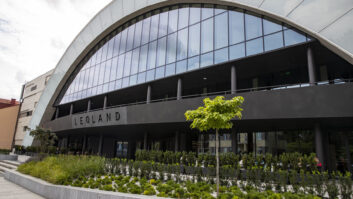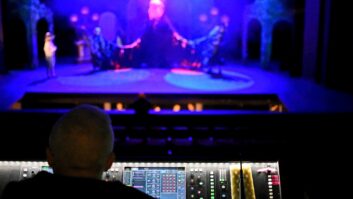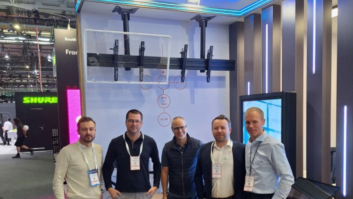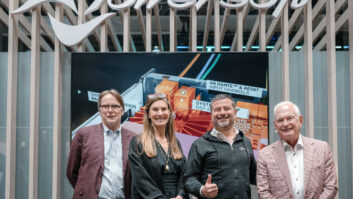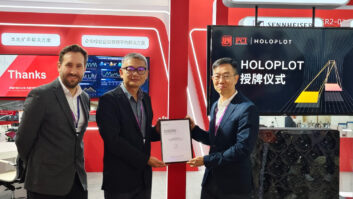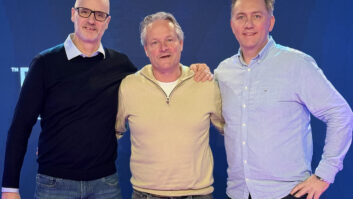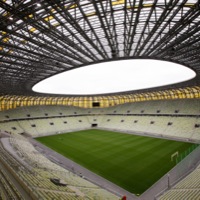
From South Africa to Germany to China, the motivational effect of major sporting championships on new infrastructural endeavours can be both significant and enduring. While new stadia developments are often the most salient symptoms, the benefits transcend the construction industry to encompass retail, hospitality and many other vital contributors to a nation’s economy. Poland is a case in point. In a few weeks’ time, it will co-host, with Ukraine, the 2012 UEFA European Football Championship, otherwise known as Euro 2012. Speak to AV professionals in the country, and it is clear that preparations for the event have necessitated considerable investment in new and existing facilities by both Government and European bodies. The result has been a series of rewarding projects that have helped to enliven the sector through a period that might otherwise have been characterised by economic uncertainty. Indeed, it is difficult to underestimate the role played by European Union money since Poland became a member of the EU in 2004. Access to EU cash has helped to stabilise an economy that escaped many of the worst effects of the 2008-10 global recession. Nonetheless, serious problems remain: unemployment remains high at around the 12% mark, while inflation is another persistent concern. In 2012 – and in common with many of its European neighbours – the Polish Government is striving to balance deficit-reduction policy with measures intended to stimulate renewed business activity. One imagines, therefore, that the administration could be rather enthusiastic for the arrival of Euro 2012 – an event that should deliver a boost to both national morale and Poland’s profile on the world stage. Activity levels Although there is fulsome recognition of the country’s current challenges, most distributors and installers who spoke to IE did not appear to be overly preoccupied by the economic situation. Certainly, there is a feeling that Poland’s retention of its own currency, the Zloty, has served to mitigate some of the worst effects of the Eurozone crisis. “Luckily, Poland is not affected that much directly by the credit crunch and unstable Euro currency, [and as a result] we still observe some growth of GDP, which gives a glimmer of hope to all of us involved in the AV industry in Poland,” said Kris Bocian of independent AV consultancy AV4U. Zbigniew Klonowski, president of the board at AV solutions provider Trias SA – which works with brands including Christie, Extron, NEC, Dactronics and Panasonic – is also upbeat. Reporting a busy first half, he expects that the second half of 2012 will register “stable growth with [an] upward trend”. In terms of individual company activity levels, most contributors suggested that business was at least equal to the same point in 2011. Work levels, said Maciej Kapica of systems designer/installer eKap, are “more or less the same”. More typical was the response given by Agata Kielar-Nowak, international cooperation manager at sales/distribution company Shadok AV: “The business at the moment is definitely doing better than this time last year, as 2011 was the key point for our company. During that time we managed to get many prestigious contracts, which in turn gave us references [that will allow us] to concentrate on much bigger and more challenging projects in future.” Also reporting an upward trend that to some extent belies the wider economic context was Michal Bisikiewicz, managing director of GIG Ltd, which acts as a distributor for the likes of Christie, Zero88, HighEnd and A&O Technologies. “We enjoy a very big interest in the world brand products which we have in our [portfolio]. Last year we doubled our turnover and this year we expect [a] further 30% growth,” he said. “Our financial results have improved due to the [enhanced offer] of multimedia technologies, [and] we have captured many new customers, especially among installers.” But the positive outlook is by no means universal. Bogdan Leszko is the owner of pro-audio and voice alarm specialist Bel Aqustic, which distributes brands including Baldwin Boxall, Sabine, RCF and Penton. “A few years ago, there was huge interest [with regard to] the pro-audio market, and nowadays I observe complete stagnation,” said Leszko, who is also involved in not-for-profit intelligent sound solution information provider Bellsonic. “Private investors are waiting for the markets to recover, or have already built what they need, [while] Government investments are postponed or cancelled as money is redirected towards Euro 2012 investments. [In any case] due to the recent economic situation, there is less money to spend than in the previous years.” Leszko added: “Last year many tenders were published as required by the investors; they were finalised, winners were chosen and then nothing happened. [Subsequently] they were postponed until later because there is no cash [to realise them].” Bocian echoed some of these concerns: “Some of the projects we worked on last year were cancelled; some of them have new, smaller budgets. There are also payment issues. This [gives rise to a] very difficult situation, especially for smaller dealers/installers, who can’t afford any delays in payment.” The Euro 2012 effect Most contributors were broadly positive about next month’s football championship, for which Poland will provide four out of eight host venues: Warsaw’s National Stadium, Gdañsk’s PGE Arena, Wroclaw’s Municipal Stadium and Poznañ’s Municipal Stadium. With the exception of the Poznañ facility – which has nonetheless been the subject of a significant overhaul – all venues are new and purpose-built. Road and rail links to host stadia have also been the subject of extensive investment. “In 2011, [a] substantial part of our income was generated by realisations in sporting complexes, related [to the] development of infrastructure for the Euro 2012 championships,” said Klonowski from Trias SA, whose recent project roll-call includes serving as the official technology partner and general contractor of ‘tele-technical’ systems for the aforementioned PGE Arena. Professional service provider Digiservice is another beneficiary of the Euro 2012 effect, having been involved with the Poznañ and Gdañsk stadium projects. CEO Robert Tuczyñski underlined the importance of the championship to Digiservice’s 2012: “This year we are going to concentrate mainly on supporting events related to Euro 2012 as well as on reaching the digital cinema industry with our maintenance servicing and distribution offer.” Technological trends As far as Klonowski is concerned, the Polish market is very “open to new solutions and technologies” – a view that would appear to be supported by the high-end AV and intercom deployments found across the new football venues. But what of the technological trends that are truly permeating the full spread of Poland pro-AV – from deployments in huge stadia to more everyday usage in colleges and leisure facilities? For the sheer number of mentions alone, one should probably place new visual display technologies at the top of the pile. Citing increased demand for advertising applications, Tuczyñski observed that “the LED technology has been developing very rapidly”. Increased availability of large LED media can be linked to two primary factors: “Prices are going down [at the same time as] the products are being enhanced.” Similarly, Piotr Wierzbicki from projector specialist Optoma Europe remarked that “in some cases, bigger installations are switched [towards] public displays and video walls. The larger installations are also driven by the European [football] championship.” As well as highlighting the trend towards LED deployments, Klonowski pinpointed “a great interest in permanent comprehensive installations using multimedia projection systems. Increasingly, these are used not only in conference rooms or TV studios, but in museums and all kinds of exhibitions as well.” Elsewhere, Klonowski identified the popularity of plasma and LCD monitors for installations in offices, banks and other commercial public facilities. There were also multiple allusions to interactive whiteboards and their positive contribution to the education market, which is evidently an important one for many Polish distributors and installers. “We have to mention the education sector and [the] interactive products [which are] enhancing the work of both teachers and students, such as interactive whiteboards. The reason for that development is the possibility of financing the supply of products from the funds provided by EU projects,” said Kielar-Nowak. The importance of the education market was underlined by Jerzy Gil, president of the board/managing director for AV.Net, which serves as a dealer for some brands (eg. Loewe, Sharp, Denon) and a distributor for others (JVC, Extron, Mitsubishi Electric). “For [growth of the] education sector, EU support is essential; for home cinema, it is the continuous increase of the Polish citizens’ income,” observed Gil. Other discernible trends – many of which appear to cut across applications and market sectors – include increased demand for the streaming of audio and video content, ‘smart’ TV systems, iOS/Android-based control technology, and wireless system implementation in general. Market changes and finance In terms of distribution arrangements, the general consensus is that the Polish market has registered few significant changes of late. In particular, noted Leszko, set-ups for the “big brands are rather stable. It is rare (but not impossible) that they change distributor – because they are strong.” “Service of the biggest brands in Poland is [stable],” echoed Tuczyñski, adding that “manufacturers often consolidate the service with [the] distribution channels of their brands. It is not uncommon for distributors and installers to be responsible for the same area.” On a related note, Optoma’s Wierzbicki confirmed that the Polish AV market remains decidedly diverse with regard to its deployment of distribution models: “Some brands operate only with a direct dealer/integrator network; others use the distributor-dealer model. There are also mixed models using both distributor-dealer and direct dealer market approaches. The general tendency on the market is to have direct touch with AV dealers and integrators as they are [the key chains] during a project – from the design stage [to] the completed installation.” But while high-profile distribution arrangements appear to be fairly settled, credit and finance terms are the subject of greater flexibility. “On a daily basis, we are usually working with traditional credit terms,” said Kielar-Nowak. “However, when working on more challenging contracts we are frequently asked [about] lengthening the payment terms, which is always the subject of individual negotiation with the customer.” Tuczyñski noted that Digiservice has been offering “advantageous conditions of financial settlements for our regular customers and partners”, while Bel Aqustic’s Leszko observed that he can “only offer terms similar to what I get from my partners. If they change terms I must respond, and lately it is [a] one-way process – shorter payment terms.” Maturing market In parallel with Poland’s increased presence on the global stage since the early Noughties, the overriding impression is of a country whose pro-AV sector is now reaching maturity. Multiple contributors alluded to strong interest in new technologies, including audio networking and high-end visual display systems – a trend underlined by the world class installations found in the new football stadia. While there are those who would like to see Poland adopt the Euro at some point in the future, retention of a national currency has shielded the country from some of the global slowdown’s worst effects. For pro-install, these favourable circumstances dovetail neatly with an install business that is continuing to blossom across segment and sector. www.av.net.plwww.bellsonic.org.plwww.ekap.plwww.av4u.plwww.optoma.plwww.shadok.plwww.trias.pl
